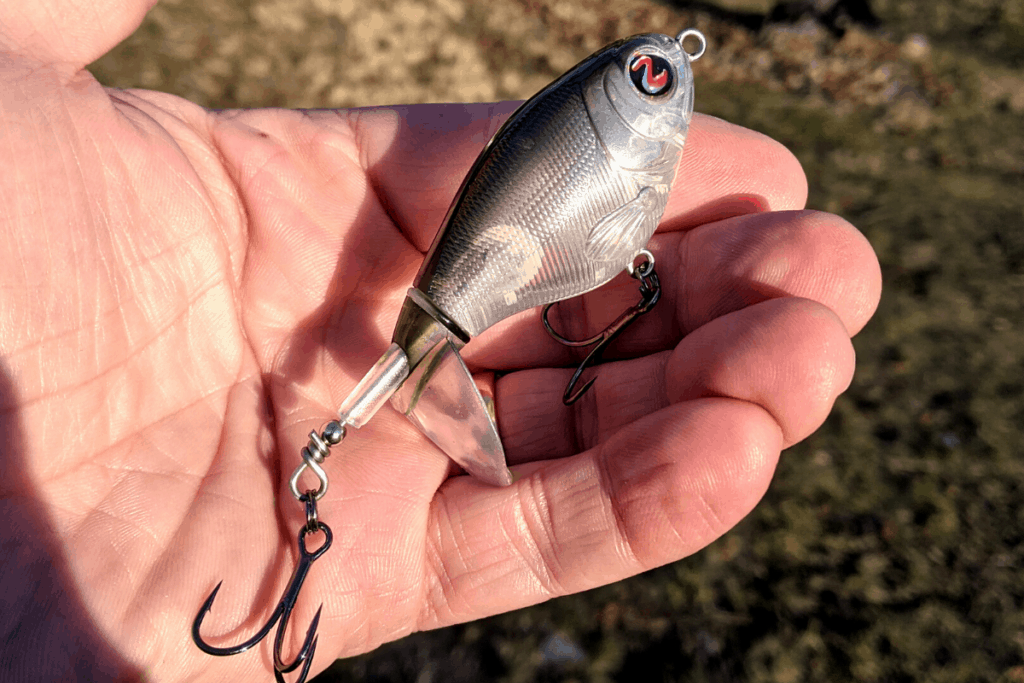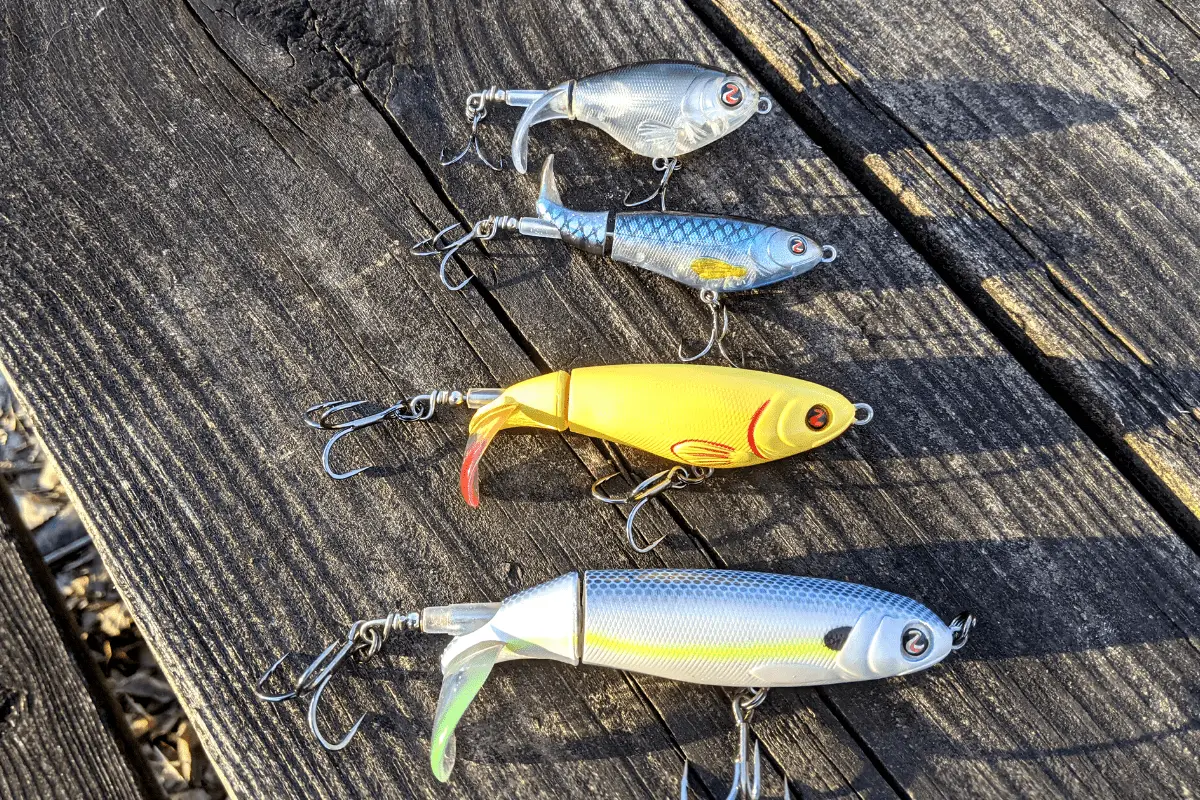In recent years, few lures have garnered as much attention as the River2Sea Whopper Plopper – and for good reason. The lure has created a different sound signature and surface disturbance that bass have found irresistible.
Selecting the right Whopper Plopper for the conditions is key to getting the most from the lure.
If the water is calm or has a slight surface ripple, a size 75 or 90 Whopper Plopper is ideal. In a stronger wind try a model 110 or larger. Baitfish size is also important. Use the 75 or 90 version if the baitfish are smaller and a larger Whopper Plopper for bigger baitfish, like gizzard shad.
Understanding the characteristics and benefits of each size Whopper Plopper will help you make critical on-the-water decisions that will bring more fish to the boat.
Choosing a Whopper Plopper Based on the Wind
This is the first item taken into consideration when deciding on what Whopper Plopper to pull out of the box.
The lure has an uncanny ability to maintain a surface disturbance even with a chop on the water. Many lures do their best work in calm conditions, but this bait is different.
If the water is calm, start with the size 75 or 90.
These two models create the perfect amount of surface ripple in slick conditions.
When a slight chop forms on the water, the 90 or 110 will get the job done. I prefer to start with the smaller size 90 if I can since most of the waters I fish have small minnows as a key forage base.

In a stronger wind, the two largest versions get top billing. The size 130 has worked for me on windy days and the size 190 gets tied on if the bass lurking in the water have true potential as giants.
Whopper Plopper Sizes
| Model | Length in Inches | Weight in Ounces |
| 60 | 2 3/8″ | 1/4 oz |
| 75 | 3″ | 3/5 oz |
| 90 | 3 1/2″ | 1/2 oz |
| 110 | 4 3/8″ | 1 oz |
| 130 | 5″ | 1 3/8 oz |
| 190 | 7 1/2″ | 2 3/4 oz |
Choosing a Whopper Plopper Based on the Forage
This element of a lake or river needs to be taken into consideration almost in lock-step with the amount of wind on any given day.
Forage varies in size from one location to the next – even impoundments a few miles apart. An angler may find threadfin shad in one and gizzard shad in the other.
Places like southern California have lots of trout tempting hungry bass while Lake Champlain out east is flush with yellow perch. Sunfish are an often overlooked prey species for bass that also need to be factored in to the decision making process.
Choose a Whopper Plopper that most closely resembles the forage you believe the bass are keyed in on.
The waters I fish, with plenty of minnows and sunfish, see lots of action from the size 75, 90, and the 110 on windy days. I have the larger sizes, but those are reserved for trips when I am fishing waters with lots of gizzard shad.
If there were trout in the places I fish then the size 130 would get a good workout.

Color Choice for Whopper Ploppers
This decision is also based on the forage, but water clarity is a factor as well.
In dirty and heavily stained water, solid colors like black are going to be the first out of the box.
The clearer the water the more natural the colors. If bluegills are everywhere, then I will select a Whopper Plopper that has more yellows and greens in it. When attempting to match minnows I will stick with the grays, silvers, and whites.
In clean water the color choice has a more noticeable impact on the quality and amount of bites an angler gets.
(Here is an article that discusses choosing the right topwater for the situation.)
Where to Throw a Whopper Plopper
This surface lure does a great job of pulling bass from cover.
Running it alongside laydowns, docks, and parallel with rip-rap shorelines can draw bites from bass hiding in there, but a Whopper Plopper also excels at calling bass from open water.
Few surface lures have the ability to pull bass up from deep water.
This one does.
I have been fishing a Whopper Plopper in open water that is 25 – 30ft deep and witnessed largemouth come from the depths to obliterate it.
Keep this in mind when out fishing for the day. If you have been working the visible cover and then come to a long tapering point, be sure to work the lure the full length of the point. Toss it and bring it back from multiple angles searching for where the bass are holding.
There may be a big boulder or hump sitting in deep water.
That enticing retrieve from the Whopper Plopper may just pull them off of it and you will get a topwater blowup in places you never imagined.
Retrieve Speed for a Whopper Plopper
This is probably the most overlooked aspect of fishing a Whopper Plopper.
So where do we start?
I like to throw the lure out, retrieve it, and then listen. When I hear the prop making the most noise I know I am using a great starting retrieve.
Depending on how the bass bite, anglers can speed up or slow down the bait. A Whopper Plopper is effective just chugging along or being burned.
Reading how the bass bite will tell you if your retrieve is effective.
When the bass are hitting the lure aggressively and engulfing it you can be rest-assured the color and retrieve speed are dialed in.
If you notice the bass are coming up slowly behind it and just nipping at the tail, or only getting hooked on the back treble, it is time to mix up the retrieve speed and maybe the color.
For example, on one recent outing, I was bringing the lure back where it was making the most noise – a great starting retrieve. But the bass were barely getting hooked or following the Whopper Plopper and then turning away.
I slowed the bait down to a methodical gurgle and the bite drastically improved.
Experiment and vary the cadence, color, and size until the bite is solid.
When to Choose a Whopper Plopper Over a Buzzbait
This is a great question.
While there are many conditions where either topwater will work, there are a few critical situations where I will pull out one over the other.
If there is much debris on the water, a buzzbait will do a better job. The trebles hanging below a Whopper Plopper are more likely to get hung on leaves, floating vegetation, or other foliage on the surface.
A buzzbait will also do a better job of working its way over weeds that are almost emergent.
Buzzbaits also offer anglers the opportunity to add plastic trailers that can entice wary bass to bite. The arm can also be slightly bent to ensure the blade hits it creating a different sound signature.
A Whopper Plopper will get the nod if I want to fish quicker or if the wind is strong.
It is also important to take into consideration what other anglers are throwing since bass will develop a memory from negative stimulus. If you see lots of anglers throwing a Whopper Plopper on a nice summer evening, then a buzzbait will likely be the lure of choice since it is not quite as popular at the moment.
Final Thoughts
The Whopper Plopper is a formidable topwater that offers anglers a variety of situations where it can shine.
Choose the size based on wind conditions and the forage base.
Adjust the retrieve speed and color until the bass hit the lure aggressively and avoid nipping just the back treble and you will be on your way to a fun day on the water.
Tight lines. Be safe and make sure to encourage someone today. You never know how you may change their life forever.
Isaiah 6:8

